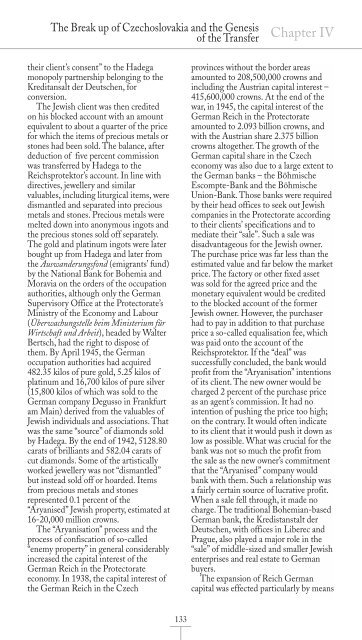the nationality of all inhabitants of the czech provinces and ...
the nationality of all inhabitants of the czech provinces and ...
the nationality of all inhabitants of the czech provinces and ...
Create successful ePaper yourself
Turn your PDF publications into a flip-book with our unique Google optimized e-Paper software.
The Break up <strong>of</strong> Czechoslovakia <strong>and</strong> <strong>the</strong> Genesis<br />
<strong>of</strong> <strong>the</strong> Transfer<br />
<strong>the</strong>ir client’s consent” to <strong>the</strong> Hadega<br />
monopoly partnership belonging to <strong>the</strong><br />
Kreditansalt der Deutschen, for<br />
conversion.<br />
The Jewish client was <strong>the</strong>n credited<br />
on his blocked account with an amount<br />
equivalent to about a quarter <strong>of</strong> <strong>the</strong> price<br />
for which <strong>the</strong> items <strong>of</strong> precious metals or<br />
stones had been sold. The balance, after<br />
deduction <strong>of</strong> five percent commission<br />
was transferred by Hadega to <strong>the</strong><br />
Reichsprotektor’s account. In line with<br />
directives, jewellery <strong>and</strong> similar<br />
valuables, including liturgical items, were<br />
dismantled <strong>and</strong> separated into precious<br />
metals <strong>and</strong> stones. Precious metals were<br />
melted down into anonymous ingots <strong>and</strong><br />
<strong>the</strong> precious stones sold <strong>of</strong>f separately.<br />
The gold <strong>and</strong> platinum ingots were later<br />
bought up from Hadega <strong>and</strong> later from<br />
<strong>the</strong> Ausw<strong>and</strong>erungsfond (emigrants’ fund)<br />
by <strong>the</strong> National Bank for Bohemia <strong>and</strong><br />
Moravia on <strong>the</strong> orders <strong>of</strong> <strong>the</strong> occupation<br />
authorities, although only <strong>the</strong> German<br />
Supervisory Office at <strong>the</strong> Protectorate’s<br />
Ministry <strong>of</strong> <strong>the</strong> Economy <strong>and</strong> Labour<br />
(Überwachungstelle beim Ministerium für<br />
Wirtschaft und Arbeit), headed by Walter<br />
Bertsch, had <strong>the</strong> right to dispose <strong>of</strong><br />
<strong>the</strong>m. By April 1945, <strong>the</strong> German<br />
occupation authorities had acquired<br />
482.35 kilos <strong>of</strong> pure gold, 5.25 kilos <strong>of</strong><br />
platinum <strong>and</strong> 16,700 kilos <strong>of</strong> pure silver<br />
(15,800 kilos <strong>of</strong> which was sold to <strong>the</strong><br />
German company Degusso in Frankfurt<br />
am Main) derived from <strong>the</strong> valuables <strong>of</strong><br />
Jewish individuals <strong>and</strong> associations. That<br />
was <strong>the</strong> same “source” <strong>of</strong> diamonds sold<br />
by Hadega. By <strong>the</strong> end <strong>of</strong> 1942, 5128.80<br />
carats <strong>of</strong> brilliants <strong>and</strong> 582.04 carats <strong>of</strong><br />
cut diamonds. Some <strong>of</strong> <strong>the</strong> artistic<strong>all</strong>y<br />
worked jewellery was not “dismantled”<br />
but instead sold <strong>of</strong>f or hoarded. Items<br />
from precious metals <strong>and</strong> stones<br />
represented 0.1 percent <strong>of</strong> <strong>the</strong><br />
“Aryanised” Jewish property, estimated at<br />
16-20,000 million crowns.<br />
The “Aryanisation” process <strong>and</strong> <strong>the</strong><br />
process <strong>of</strong> confiscation <strong>of</strong> so-c<strong>all</strong>ed<br />
“enemy property” in general considerably<br />
increased <strong>the</strong> capital interest <strong>of</strong> <strong>the</strong><br />
German Reich in <strong>the</strong> Protectorate<br />
economy. In 1938, <strong>the</strong> capital interest <strong>of</strong><br />
<strong>the</strong> German Reich in <strong>the</strong> Czech<br />
133<br />
Chapter IV<br />
<strong>provinces</strong> without <strong>the</strong> border areas<br />
amounted to 208,500,000 crowns <strong>and</strong><br />
including <strong>the</strong> Austrian capital interest –<br />
415,600,000 crowns. At <strong>the</strong> end <strong>of</strong> <strong>the</strong><br />
war, in 1945, <strong>the</strong> capital interest <strong>of</strong> <strong>the</strong><br />
German Reich in <strong>the</strong> Protectorate<br />
amounted to 2.093 billion crowns, <strong>and</strong><br />
with <strong>the</strong> Austrian share 2.375 billion<br />
crowns altoge<strong>the</strong>r. The growth <strong>of</strong> <strong>the</strong><br />
German capital share in <strong>the</strong> Czech<br />
economy was also due to a large extent to<br />
<strong>the</strong> German banks – <strong>the</strong> Böhmische<br />
Escompte-Bank <strong>and</strong> <strong>the</strong> Böhmische<br />
Union-Bank. Those banks were required<br />
by <strong>the</strong>ir head <strong>of</strong>fices to seek out Jewish<br />
companies in <strong>the</strong> Protectorate according<br />
to <strong>the</strong>ir clients’ specifications <strong>and</strong> to<br />
mediate <strong>the</strong>ir “sale”. Such a sale was<br />
disadvantageous for <strong>the</strong> Jewish owner.<br />
The purchase price was far less than <strong>the</strong><br />
estimated value <strong>and</strong> far below <strong>the</strong> market<br />
price. The factory or o<strong>the</strong>r fixed asset<br />
was sold for <strong>the</strong> agreed price <strong>and</strong> <strong>the</strong><br />
monetary equivalent would be credited<br />
to <strong>the</strong> blocked account <strong>of</strong> <strong>the</strong> former<br />
Jewish owner. However, <strong>the</strong> purchaser<br />
had to pay in addition to that purchase<br />
price a so-c<strong>all</strong>ed equalisation fee, which<br />
was paid onto <strong>the</strong> account <strong>of</strong> <strong>the</strong><br />
Reichsprotektor. If <strong>the</strong> “deal” was<br />
successfully concluded, <strong>the</strong> bank would<br />
pr<strong>of</strong>it from <strong>the</strong> “Aryanisation” intentions<br />
<strong>of</strong> its client. The new owner would be<br />
charged 2 percent <strong>of</strong> <strong>the</strong> purchase price<br />
as an agent’s commission. It had no<br />
intention <strong>of</strong> pushing <strong>the</strong> price too high;<br />
on <strong>the</strong> contrary. It would <strong>of</strong>ten indicate<br />
to its client that it would push it down as<br />
low as possible. What was crucial for <strong>the</strong><br />
bank was not so much <strong>the</strong> pr<strong>of</strong>it from<br />
<strong>the</strong> sale as <strong>the</strong> new owner’s commitment<br />
that <strong>the</strong> “Aryanised” company would<br />
bank with <strong>the</strong>m. Such a relationship was<br />
a fairly certain source <strong>of</strong> lucrative pr<strong>of</strong>it.<br />
When a sale fell through, it made no<br />
charge. The traditional Bohemian-based<br />
German bank, <strong>the</strong> Kredistanstalt der<br />
Deutschen, with <strong>of</strong>fices in Liberec <strong>and</strong><br />
Prague, also played a major role in <strong>the</strong><br />
“sale” <strong>of</strong> middle-sized <strong>and</strong> sm<strong>all</strong>er Jewish<br />
enterprises <strong>and</strong> real estate to German<br />
buyers.<br />
The expansion <strong>of</strong> Reich German<br />
capital was effected particularly by means


